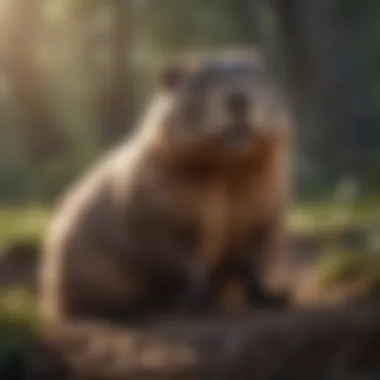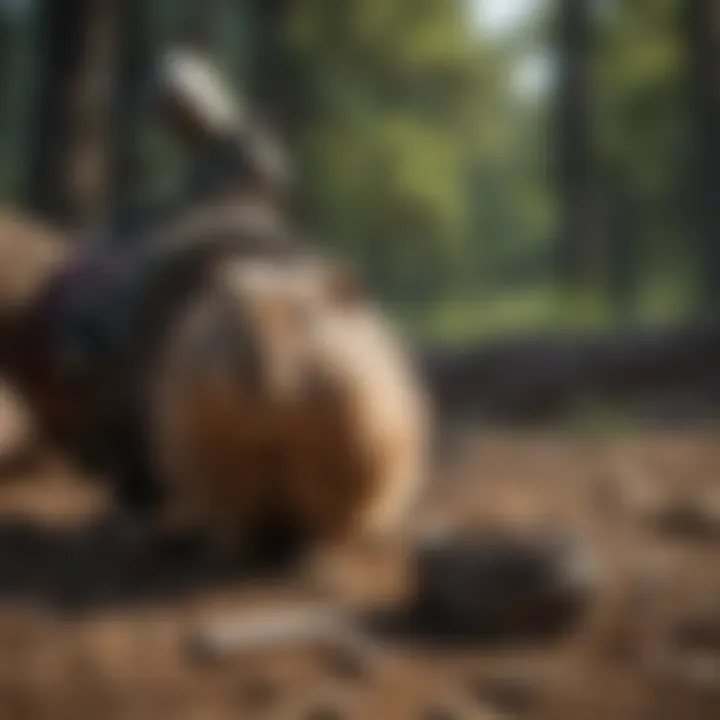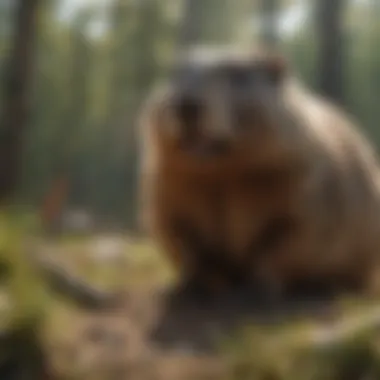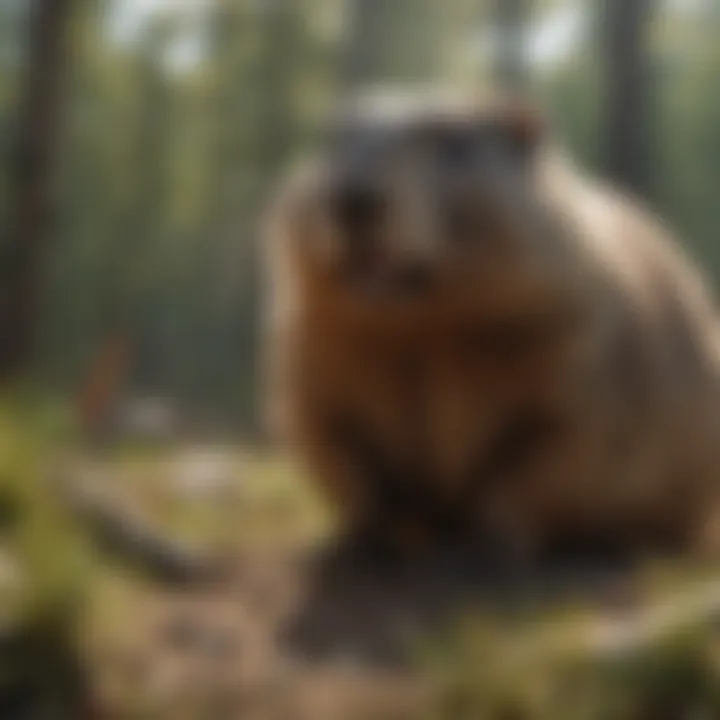Expert Tips for Successfully Catching Groundhogs


Intro
Groundhogs, often referred to as woodchucks, occupy a unique position in the ecosystem. They are known not only for their burrowing habits but also for their appetite for gardens and crops. Understanding how to catch them requires knowledge of their behavior and habitat as well as the right methods, tools, and ethical considerations. This guide aims to provide a thorough exploration into effective strategies for capturing groundhogs while considering their ecological impact.
Understanding Pests
Definition of Pests
Pests are organisms that negatively affect human activities and the environment. In this context, groundhogs are categorized as pests mainly due to their tendency to damage gardens and farmland. They can consume a variety of plants, leading to frustration among homeowners and gardeners.
Importance of Pest Identification
Identifying the specific type of pest is crucial in managing their populations effectively. Knowing the nature of groundhogs allows for more tailored control strategies. Understanding their habits and habitats helps predict their movements and interactions with human spaces. This knowledge is vital for developing an effective capture plan that minimizes harm to the animal and surrounding ecosystem.
Prevention Techniques
Home and Garden Preventative Measures
While trapping is an effective way to manage groundhogs, prevention can reduce the likelihood of their presence. Here are some effective prevention techniques:
- Fencing: Installing a fence that extends at least a foot underground can deter groundhogs from burrowing into gardens. A fence height of three feet is generally sufficient to prevent them from climbing over.
- Plant Selection: Choose plants that groundhogs typically avoid, such as thorny species or those with strong scents. This helps protect your garden from being an attractive meal.
- Cleaning Up Debris: Keeping garden areas clean and free of debris minimizes nesting opportunities for groundhogs.
Seasonal Prevention Tips
Groundhog activity can vary with the seasons, so adjusting your prevention techniques accordingly can be beneficial. In spring, when groundhogs emerge from hibernation, implement fencing and plant barriers. By late summer, ensure that you clear any crop remains, which might attract them to your garden.
Eco-Friendly Pest Control Solutions
Overview of Sustainable Practices
Eco-friendly pest control involves methods that minimize harm to both the environment and the pests themselves. Using traps designed for a humane catch-and-release approach can reduce suffering and allow for relocation. Encouraging natural predators, such as foxes, can also help keep the groundhog population in check.
Natural Remedies and Their Effectiveness
Utilizing natural remedies can deter groundhogs without resorting to harsh chemicals. Some remedies include:
- Garlic Wasps: Spraying a mixture of garlic and water can repel groundhogs due to their strong scent.
- Castor Oil: This is known to make plants unpalatable to groundhogs. Diluting castor oil with water and spraying it around your garden can be effective.
It's crucial to consider the implications of any method you choose. Responsible management includes ensuring that control efforts do not harm non-target species or disrupt local ecosystems.
Understanding the Groundhog
Understanding the groundhog is essential for effective trapping and management. Groundhogs, also known as woodchucks, are a species that can significantly impact gardens and landscapes. Therefore, knowing their behaviors, preferences, and habitats helps in devising effective strategies for controlling their populations. This section will cover the species overview, their behavioral patterns, and habitat and range, offering valuable insights to homeowners and gardeners.
Species Overview
The groundhog, or Marmota monax, belongs to the rodent family Sciuridae. They are large ground squirrels, widely recognized for their stocky bodies and short legs. Typically, they weigh between 5 to 14 pounds and adults measure around 16 to 26 inches in length, including their bushy tails. Groundhogs display a robust, sturdy appearance, which is well adapted to their burrowing lifestyle.
Groundhogs are primarily herbivorous, feeding on a wide variety of plants, including grasses, fruits, and vegetables. Their diet might pose a challenge for gardeners, making it crucial to understand when and how they forage. In many regions, groundhogs are common and can become a nuisance due to their tendency to dig extensive burrows and damage crops.
Behavioral Patterns
Groundhogs are diurnal, meaning they are active during the day. This behavior allows for easy observation and identification. They typically emerge from their burrows around sunrise and remain active until sunset. Socially, groundhogs are mostly solitary, except during the breeding season, which occurs from March to July. Understanding these behavioral patterns can guide effective trapping periods.
When threatened, groundhogs tend to exhibit specific behaviors. They may freeze or run back to their burrows. Their burrowing habits are notable; they create complex underground systems that can extend up to 30 feet and include multiple entrances. This leads to issues when trying to control their populations, as they can quickly retreat underground and evade capture.
Groundhogs can dig burrows that create extensive networks, allowing them to hide effectively from predators and humans alike.
Habitat and Range
Groundhogs prefer a mix of open fields, meadows, and forests, often located near agricultural areas. Their range spans much of North America, extending from Canada down into the eastern and central United States. They thrive in areas where there is a plentiful supply of vegetation for feeding and soil suitable for burrowing.
In urban environments, groundhogs can adapt well, often finding refuge in gardens and parks. As such, understanding where they thrive helps in determining the best locations for trapping efforts. Recognizing these aspects of their habitat enables homeowners to anticipate potential problems and implement preventive measures.
By grasping the fundamentals of groundhog species, behaviors, and habitats, one can lay a solid foundation for effective groundhog management. With this knowledge, homeowners can better protect their gardens while respecting these creatures' ecological roles.
Impact of Groundhogs on Gardens
Understanding the impact of groundhogs on gardens is essential for homeowners and gardeners who wish to maintain healthy and thriving outdoor spaces. Groundhogs, also known as woodchucks, are herbivores that primarily feed on a variety of plants. Their foraging behavior can lead to significant damage to gardens, making it vital to grasp both the nature of the damage and the broader ecological role they play.
Damage to Plants


Groundhogs are notorious for their destructive feeding habits. They prefer soft, tender plants, making vegetables like lettuce, peas, and beans prime targets. Groundhogs can devastate a garden overnight. Their strong incisors enable them to gnaw through stems and roots, leading to immediate wilting and eventual plant death. This can result in severe financial losses for those relying on home-grown produce.
The extent of damage can vary depending on the size of the groundhog population in the area. Multiple groundhogs can quickly reduce a lush garden to a barren patch. They tend to forage at dawn and dusk, often unnoticed until significant harm has been done. Homeowners must remain vigilant, as even a few groundhogs can create a shocking amount of destruction within days.
To mitigate this risk, it is crucial to employ proactive measures. These may include physical barriers, like fencing, that can deter groundhogs from entering the garden. Using chicken wire or hardware cloth can be effective; however, it must be buried at least a foot underground, as groundhogs are adept diggers.
Ecosystem Role
Despite their reputation, groundhogs serve essential functions within the ecosystem. Their burrowing activities aerate the soil, promoting better drainage and root growth for surrounding plants. When they dig, they also create habitats for other small animals and insects, which can contribute to biodiversity in the garden area.
Groundhogs play a part in the food chain. They serve as prey for sizable predators, including coyotes and hawks. Their grazing helps regulate plant growth, which prevents any one species from overwhelming the area. Therefore, while gardeners need to manage their impact on cultivated plants, acknowledging the multifaceted role of groundhogs in the ecosystem is also important.
"Holding a nuanced view of groundhogs can help us develop effective coexistence strategies that benefit both the garden and local wildlife."
Balancing the need to protect gardens while appreciating the ecological contributions of groundhogs requires thoughtful strategies. Solutions such as companion planting, which involves growing certain plants together to deter pests, can allow for a more harmonious relationship with these creatures. Ultimately, understanding both their negative impact and ecological benefits can guide gardeners to more sustainable practices.
Legal Considerations for Groundhog Trapping
Understanding the legal framework surrounding groundhog trapping is crucial for anyone looking to manage these animals effectively. Ignoring the laws may lead to penalties, making it imperative to educate oneself on what is permissible in your region. This section focuses on local laws and regulations that govern the capture of groundhogs and ethical practices to consider during the process.
Local Laws and Regulations
Local laws concerning groundhog trapping vary widely across regions. Some states allow groundhog trapping for pest management, while others may have restrictions in place, particularly during breeding seasons. Here are some key points to consider:
- Licenses and Permits: Always check if a trapping license is required in your area. Some jurisdictions necessitate specific permits for trapping groundhogs.
- Trapping Seasons: Certain states have designated seasons for trapping. Ensure that you are trapping during the legal time frame, as illegal trapping can lead to fines.
- Humane Regulations: Many places have regulations that require the use of humane traps. This is one measure that aims to protect animal welfare during the trapping process.
- Reporting Protocols: In some areas, there could be a requirement to report the capture of certain species. Familiarize yourself with these protocols.
Staying informed about these regulations not only aids compliance but also promotes responsible trapping practices.
Ethical Trapping Practices
Ethical considerations are paramount when attempting to trap groundhogs. This ensures that the process remains humane and responsible, which is not just legally sound but also morally right. Here are some effective strategies:
- Use Humane Traps: Select traps designed for humane capture. Live traps minimize harm to the animal while allowing for relocation.
- Check Traps Regularly: Traps should be monitored daily to minimize stress and suffering for captured groundhogs. Prolonged captivity can lead to unnecessary distress.
- Know Your Release Area: When relocating groundhogs, make sure to choose an appropriate area that is far from human development, ensuring the animal can thrive in a new environment.
- Educate Others: Share knowledge about ethical trapping within your community to promote responsible practices.
Important Note: Ethical trapping practices contribute to the welfare of captured animals and foster a sustainable interaction with local wildlife.
By understanding local laws and committing to ethical trapping practices, homeowners can effectively and humanely manage groundhogs in their vicinity. These steps not only protect the animals but also enhance community relations and promote responsible wildlife management.
Equipment Needed for Trapping
Effective trapping of groundhogs is a nuanced task that requires the right equipment. Having proper tools is essential, as it directly impacts the success rate of your efforts. Understanding the types of traps available, selecting appropriate bait and lures, and utilizing safety gear can significantly make the trapping process more efficient and humane. Each component plays a crucial role in ensuring that you not only capture the groundhog but do so in a manner that adheres to legal and ethical standards.
Types of Traps
When it comes to trapping groundhogs, various types of traps are available, each serving different needs:
- Live traps: These traps capture groundhogs without harming them, ensuring a humane option. They allow for safe relocation.
- Kill traps: These are designed to kill groundhogs instantly. While effective, they come with ethical considerations.
- Box traps: A specific subtype of live traps, box traps are spacious and can accommodate larger adult groundhogs.
- Conibear traps: Effective for catching groundhogs, these traps require precise placement and can be deadly.
Choosing the right trap depends on your goals: whether to simply capture or to remove the animal permanently. Always follow local regulations to ensure compliance.
Bait and Lures
Bait and lures are vital in attracting groundhogs to traps. Understanding their dietary preferences helps in selecting effective bait:
- Fruits: Groundhogs are particularly drawn to apples and peaches. These can be cut into slices or whole fruits left near traps.
- Vegetables: Leafy greens, carrots, and corn are appealing choices, particularly if they are freshly harvested.
- Herbs: Strong-smelling herbs, like mint or clover, are also effective lures. These can entice groundhogs from a distance.
Employing the right bait increases the chance of a successful catch. Experiment with different options, as individual tastes may vary.
Safety Gear
While trapping groundhogs, adequate safety gear is important to protect yourself:
- Gloves: Wearing sturdy gloves prevents direct contact with traps and reduces the risk of injury. This is crucial when handling live traps.
- Long-sleeve clothing: Covering your arms and legs provides an extra defense against bites or scratches.
- Eye protection: If you are setting traps in dense underbrush, glasses can protect your eyes from debris.
Utilizing these safety measures minimizes risks involved in the trapping process. Always prioritize your safety as you go about your efforts.
Always ensure that the equipment you choose is suitable for your local wildlife regulations and humane standards.
Effective Trapping Techniques
Effective trapping techniques are critical for successfully managing groundhog populations, especially if they cause damage to gardens or lawns. A well-planned approach improves the chances of catching these creatures while being considerate of the ethical aspects involved. It's essential to understand each step in the trapping process to optimize results.


Identifying Active Burrows
Before you can set traps effectively, you must locate active burrows. Active burrows indicate a current groundhog presence. Start by looking for fresh signs such as:
- Disturbed soil around burrow entrances
- Fresh droppings near burrows
- Signs of feeding on nearby plants
- Paths or trails leading to and from burrows
It is advisable to follow these trails to gauge which burrows are frequently used. Assessing the number of entrances to a burrow system can also provide a clearer picture of the groundhog's activity. Be patient during this observation phase, as it offers necessary insight.
Setting Traps
Once active burrows are identified, the next step involves setting the traps. Choose a secure location near the burrow entrance or along established pathways. Here are some considerations when setting traps:
- Select the Right Trap: Live traps such as those made by Havahart are generally recommended. They should be large enough for groundhogs but designed to minimize harm.
- Bait the Trap Properly: Groundhogs typically respond well to bait like apple slices, carrots, or peanut butter. Place the bait at the back of the trap to encourage full entry.
- Camouflage the Trap: Concealing the trap with foliage or dirt can make it less intimidating to groundhogs. Their natural curiosity often leads them to investigate unusual objects in their environment.
- Set Traps at Dusk or Dawn: Groundhogs are primarily crepuscular, which means they are most active during early morning and late afternoon. Setting traps during these times increases the chances of a successful catch.
Always check local regulations to ensure you are compliant when setting traps.
Monitoring Traps
After traps are set, monitoring them is essential for both efficacy and ethical concerns. Here are key pointers for this step:
- Check Traps Regularly: Aim to check traps several times a day. This minimizes stress for captured animals and adheres to humane trapping practices.
- Be Prepared for Different Outcomes: You may not catch a groundhog immediately. Patience is key as it might take time for it to take the bait.
- Document Your Observations: Keeping a record of monitored traps can provide insights over time. Note whether traps were triggered and any animal signs, aiding in future trapping decisions.
- Act Quickly Upon Capture: If a groundhog is captured, handle it with caution to minimize stress. Use appropriate safety gear to protect yourself during this process.
By integrating these effective trapping techniques, you will enhance your ability to manage groundhog populations responsibly and successfully.
Handling Captured Groundhogs
Managing captured groundhogs is a critical phase in the trapping process. Proper handling ensures the safety of both the animal and the individual capturing it. Understanding the stress factors that a trapped groundhog experiences can lead to better outcomes in terms of humane treatment and successful relocation. As a house owner or gardener, treating a captured groundhog with care can also prevent negative interactions that could arise from panic or fear.
Transporting Safely
Transporting a groundhog requires careful consideration of its well-being. First, use a sturdy trap designed specifically for capturing medium-sized mammals. The trap should be adequately ventilated but secured to prevent escape. Place a blanket over the trap during transportation. This helps to minimize stress by darkening the environment and reducing the sight of potential threats.
When transporting, ensure the vehicle is quiet and minimizes sudden movements. Avoid talking excessively around the trap, as loud noises can agitate the groundhog, leading to distress. It's often advisable to keep the trip short to limit exposure to stressful stimuli.
Release Options
Once you arrive at a suitable release location, it's important to consider your options carefully. Relocation should be conducted in an area far enough from your property to prevent the groundhog from returning. Selecting a habitat provides cover, ample food supply, and a low human presence will support the animal's survival.
A common practice is to release the groundhog near wooded areas or farmland. However, consulting local regulations regarding wildlife relocation can guide you in making decisions that do not disrupt local ecosystems or violate rules. Always check to make sure it's okay to relocate the groundhog in the chosen area.
Post-Release Considerations
After the groundhog is released, it is essential to monitor the area for signs of its adaptation. Observe whether it finds shelter and food, indicating a successful integration into its new location. Maintain a distance from the release site to minimize interference with the groundhog's natural behavior.
Additionally, it is wise to evaluate your own property post-release for possible attractors that may pull in other groundhogs in the future. Consider implementing fencing solutions or other barrier methods, as these can be effective in preventing new groundhogs from establishing a territory nearby.
"Handling captured wildlife entails a responsibility to act ethically and thoughtfully toward sensitive ecological balances."
Understanding the intricacies of handling captured groundhogs demonstrates respect for wildlife and commitment to ecological health.
By ensuring safe transport, thoughtful release practices, and mindful post-release behavior, you not only contribute to the welfare of the individual animal but also support the broader ecosystem.
Alternative Groundhog Control Methods
Groundhogs can cause significant damage to gardens and landscaping. While trapping is a common method of control, considering alternative groundhog control methods is equally important. These methods offer possible solutions that can either complement trapping or serve as standalone strategies to deter groundhogs effectively. Understanding these methods is essential for creating a comprehensive pest management plan.
Fencing Solutions
Fencing is a highly effective way to keep groundhogs out of specific areas, such as gardens or tree orchards. The key is to construct a fence that is both tall and deep enough to prevent these animals from burrowing under or climbing over. A fence should ideally be at least four feet tall. Here are some tips on fencing solutions:
- Material Selection: Use sturdy materials like galvanized wire, chain link, or wooden panels. These are durable and can withstand digging.
- Depth Consideration: Extend the fence underground at least one foot to prevent burrowing. This is crucial as groundhogs are natural diggers.
- Barrier Design: An outward extension at the top of the fence can help deter climbing, making it slanted away from the secured area.
Fencing not only keeps groundhogs out but can also offer protection against other garden pests. Proper installation and maintenance are critical for long-term effectiveness.
Repellents
Repellents can add another layer of defense against groundhogs. These products and natural solutions aim to make the environment less appealing to groundhogs. There are two primary categories of repellents: commercial chemical products and natural deterrents. Both have their pros and cons:
- Chemical Repellents: Some common commercial repellents include those containing predator scents like coyote urine. These can create a sense of danger for groundhogs and encourage them to stay away.
- Natural Repellents: Many homeowners prefer natural solutions. For example, using castor oil, garlic, or hot pepper sprays can deter groundhogs due to their unpleasant smell or taste. Additionally, planting herbs like mint or lavender may help to discourage groundhogs naturally.
It's worth noting that the effectiveness of repellents can vary, and frequent reapplication may be necessary to maintain their potency.
Habitat Modification


Habitat modification focuses on altering the environment to reduce the likelihood of groundhogs nesting nearby. Creating a less hospitable setting can effectively keep groundhogs at bay. Here are some strategies to consider:
- Remove Food Sources: Groundhogs are primarily herbivores. Clearing away fallen fruit from trees, trimming overgrown shrubs, and managing weeds will help remove easy food access.
- Limit Shelter Options: Groundhogs prefer dense vegetation and cluttered areas. Keeping your garden tidy by removing debris, tall grasses, and dense shrubs will make your property less attractive to them
- Use Grassy Barriers: Planting low shrubs or tall grasses around the perimeter can act as a physical barrier. This can discourage groundhogs from entering your garden as they may feel exposed.
By adopting these habitat modification strategies, homeowners may find that groundhog activity decreases naturally.
In summary, alternative groundhog control methods such as fencing, repellents, and habitat modification provide viable options for managing these creatures without solely relying on traps. Leveraging multiple strategies can offer a more comprehensive approach to maintaining a groundhog-free environment.
Common Misconceptions about Groundhogs
Understanding the common misconceptions about groundhogs is crucial for gardeners and homeowners alike. These misconceptions can lead to ineffective control strategies, increasing the damage they cause to gardens and landscapes. By debunking myths, we can approach groundhog management with a more informed perspective. This section highlights cultural myths surrounding groundhogs and their actual ecological contributions, which can foster a more balanced view of these animals.
Cultural Myths
Many assumptions people make about groundhogs stem from cultural narratives and folklore. One prevalent myth is that groundhogs are simply pests with no redeeming qualities. This perception often leads to a one-sided view that sees them only as threats to gardens.
In reality, groundhogs have been portrayed unfairly. For example, the idea that they cause greater destruction than they really do in comparison to other garden animals is misleading. While they do dig and might uproot plants, their actions can also aerate the soil and promote new growth in certain ecosystems.
Another myth suggests that groundhogs hibernate all winter long, detached from the ecosystem. This isn't entirely accurate. They do enter a state of torpor, reducing their activity, but they can wake up to forage when conditions allow. This complicates the perception of them as entirely dormant and highlights their adaptive nature within the ecosystems they inhabit.
Ecological Contributions
Groundhogs play significant roles within their ecosystems that are often overlooked. As herbivores, they help control the growth of various plants, which contributes to ecosystem balance. Their burrowing habits also create homes for other species, such as rabbits and foxes, and provide nesting opportunities for birds.
This interconnectedness illustrates that groundhogs are more than mere pests. They participate in the food chain, serving as food for predators like coyotes and hawks. By recognizing their position in the ecosystem, we can appreciate their contributions beyond the confines of our gardens.
Understanding these aspects helps to shape a more nuanced view of groundhogs.
"Debunking the myths attached to groundhogs enriches our understanding of them and supports better management strategies."
Ecosystem Impact of Groundhog Management
Managing groundhog populations is a topic of considerable significance in the context of local ecosystems. Groundhogs, while often viewed as pests, serve a role in their habitats that can be both beneficial and detrimental. Understanding this duality is critical for homeowners and garden enthusiasts seeking effective control methods.
The management of groundhogs impacts not just the target species, but also various other flora and fauna within the ecosystem. Groundhogs contribute to soil aeration through their burrowing activities, which can enhance plant growth. However, their feeding habits can also be destructive, leading to significant damage to ornamental and agricultural plants. This balancing act calls for careful consideration in management strategies.
Incorporating the effects of groundhog management is invaluable for two main reasons:
- Biodiversity Preservation: Groundhogs interact with many species within their environment. Their presence provides food sources for predators like foxes and hawks. Therefore, losing them through unchecked trapping could disrupt food chains.
- Ecosystem Stability: Their burrowing behavior helps in the stabilization of soil and contributes to the health of the overall ecosystem. When groundhogs are managed responsibly, the ecological benefits can outweigh the damage they cause.
"Effective management of groundhogs requires a comprehensive understanding of their ecological role to maintain a balanced environment."
Interactions with Other Species
Groundhogs play a pivotal role in their ecosystems. Their interactions often involve a variety of species, both as prey and competitors. Moreover, their burrows provide shelter for several small mammals and insects, fostering biodiversity.
- Predator-Prey Relationships: Groundhogs are prey for many larger mammals and birds. Their decline can lead to an increase in pest populations, which can lead to other ecological imbalances.
- Competition: Competitors such as rabbits or chipmunks may fill the role of herbivores in their absence, sometimes leading to overgrazing in gardens and landscapes already vulnerable to damage.
The management approaches undertaken should, therefore, reflect an understanding of these interactions. Keeping a balanced perspective on both groundhogs and their ecological roles supports longer-term success in garden preservation.
Conservation Considerations
When addressing groundhog management, it is also essential to consider the conservation aspects associated with their populations. This perspective requires a shift from viewing groundhogs solely as nuisances to understanding their contributions to their habitats.
- Habitat Protection: Maintaining their natural habitats ensures that groundhog populations stay stable, benefiting other species. This protection sustains the benefits they provide, such as soil aeration and food for predators.
- Control Methods: Non-lethal control methods should be prioritized. These include fencing, habitat modification, and the use of repellents, which can minimize harm while preserving groundhog populations.
Responsible management that leans into conservation considerations not only addresses immediate concerns but also promotes long-term ecological health. Therefore, a combination of effective management practices that respects the ecosystem as a whole can yield positive outcomes for both groundhogs and the surrounding environment.
Finale
Understanding how to effectively manage groundhogs is crucial for many homeowners and gardeners. As these creatures can cause significant damage to gardens, grasping the nuances of their behavior and ecology helps in making informed decisions about trapping and control methods. The discussion in this article has highlighted essential aspects, from basic behaviors to the impact of trapping on local ecosystems. This comprehensive approach provides clear guidance, enabling better outcomes in groundhog management.
Summation of Key Points
In summary, several key points emerge from this guide:
- Groundhogs play a specific role in their ecosystems, but they can become pests in residential areas.
- Understanding local laws is essential for ethical trapping, ensuring compliance and humane treatment of animals.
- Different trapping techniques and equipment serve unique needs, from exploring burrows to monitoring traps effectively.
- Alternatives to trapping, such as fencing and repellents, can provide additional methods for groundhog control.
These points collectively inform an integrated approach to managing groundhogs, showing that awareness and knowledge are vital.
Future Considerations
Looking ahead, several factors should be considered:
- Continuing education on the behaviors and adaptations of groundhogs, as well as emerging studies on their role in local ecosystems, can refine management strategies.
- As urban environments expand, groundhog populations may change, needing adaptive management approaches.
- New trapping technologies and eco-friendly control methods will evolve, requiring homeowners to stay informed about best practices.
Engaging with local wildlife experts and resources can provide ongoing support in enhancing practices. By remaining aware and updated, homeowners can harmonize pest management with ecological welfare.



